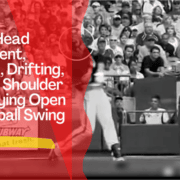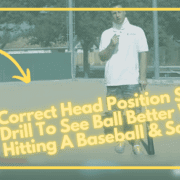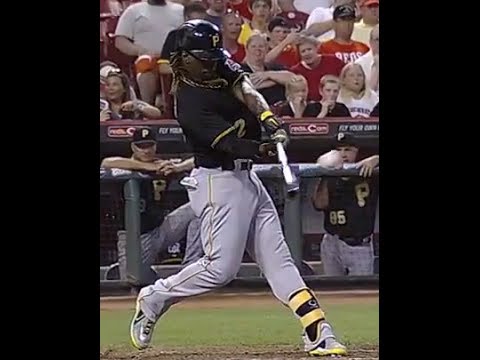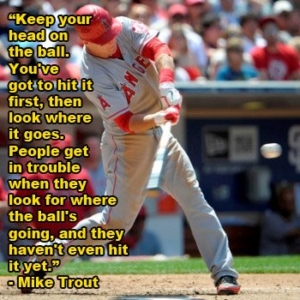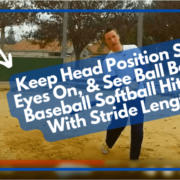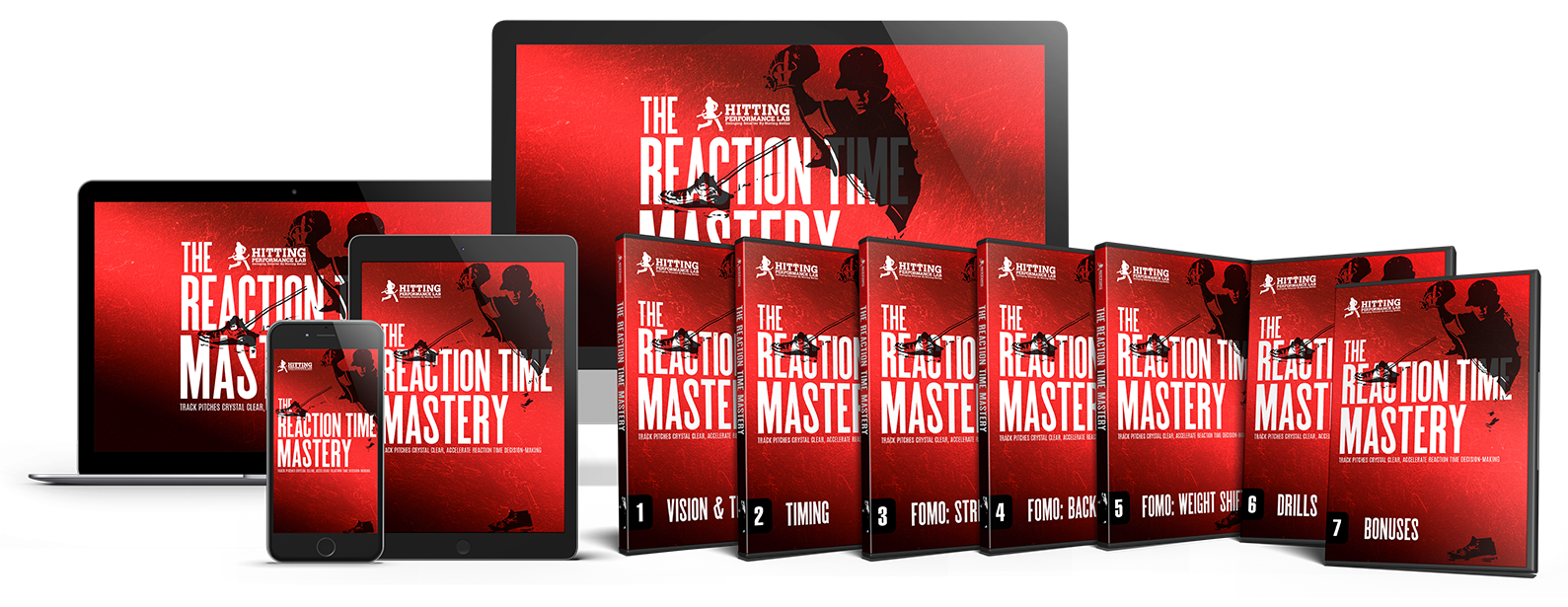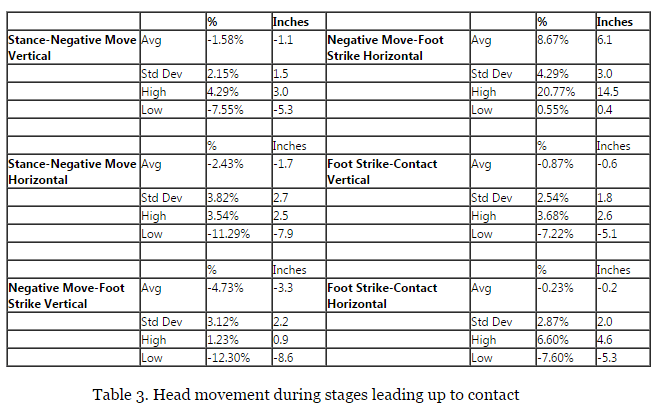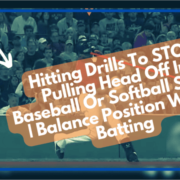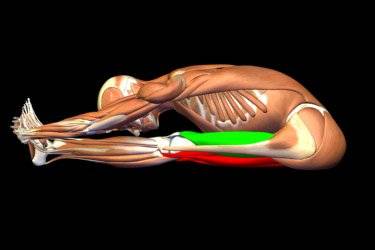Learn how to keep a hitter’s head position still, eyes on the ball, and see the baseball or softball better hitting with stride length. Discover how in these batting swing drills.
Why Late Head Movement Fails & Early Head Movement Succeeds
This is Part-3 of a 3-part softball hitting tips for kids (works well for baseball too) video series coming straight out of the Reaction Time Mastery online video course…

Sick of struggling to get your hitters on-time, balanced, and keeping high Ball Exit Speeds, especially while hitting off-speed and breaking pitches? This online video course (7-modules total) reveals cutting edge science on the topics of: Vision, Tracking, Timing, and Forward Momentum. Finally, you’ll be able to track pitches crystal clear, accelerate reaction time decision-making, & get ON-TIME without losing swing effectiveness with this “secret” online video course you can’t live without.
If you haven’t already, then CLICK the Link below to…

In this softball hitting tips for kids video post, we’ll be answering the following reader questions:
“What is your opinion of FOMO’s [Forward Momentum] impact on being able to hit the curveball? Wide stance vs. Narrow Stance in relationship to FOMO. Does wider give more balance and ability to see the ball better, recognize curveball?”
We’ll discuss:
- Myth of ‘keeping the head still’,
- Proprioception & dynamic movement,
- First baseman stretching to receive a throw, and
- Watching TV upside down…
SCIENCE-BASED TRAINING:
Improve your hitting strategy dramatically by applying human movement principles.
Learn not only how and what to train but also the science behind the methods.
Myth of ‘Keeping the Head Still’

Use the blue pole (red arrow is pointing to) as a frame of reference, and compare to Sierra Romero’s head position…down and forward. Photo courtesy of YouTube user: Tony Jimenez
CLICK HERE for a post I did analyzing Mike Trout’s swing titled, “Why Consistency Won’t Improve”. I cited a study that found it’s a physical impossibility to continuously follow the ball to the plate (for both baseball and softball), with both eyes, unless the ball is traveling 21mph, in which case, it wouldn’t make it to EITHER plate.
As the Bahill study in the above article suggests, it’s critical the hitter uses both head AND eye movements for tracking. And even more vital, is that the hitter is consistent with the pitch, roll, and yaw positions of the head.
CLICK HERE for a very candid Washington Post article featuring Greg Maddux titled, “Baseball Hall of Fame: Greg Maddux used methodical approach to get to Cooperstown”. He discussed how to make every pitch he threw look eerily similar to the hitter.
He likened this strategy to how the eyes make adjustments to driving on the freeway at high speeds. In other words, even though the odometer has read 70-mph for the past hour, your eyes may perceive your speed to be 30-mph.
According to A. Terry Bahill, their are four eye movement systems that help keep the eye fovea on the object of interest (a pitched ball):
- Saccadic – used in reading text or scanning a roomful of people,
- Vestibulo-Ocular – used to maintain fixation during head movements,
- Vergence – used when looking between near and far objects, and
- Smooth-Pursuit – used when tracking a moving object.
Bahill says these four eye movement systems have four independent control systems.
You see, we have the necessary equipment to move, track, and hit a moving object…especially when pitch speeds are being manipulated.
Which leads us to softball hitting tips for kids involving…
Proprioception & Dynamic Movement

For more clarification on this, please CLICK this graph, from the Dan Farnsworth FanGraphs article, and read under the “Keep Your Head Still” sub-title & below the graph.
So I don’t have to cover material that I’ve already covered in depth…
CLICK HERE to read a post titled, “Perfect Swing Hacking with Forward Momentum”. Pay special attention to the section sub-titled, “Balance without Thinking”.
In the same post, read the next section sub-titled, “Debunking a Common Objection & a Study”. In that part of the post, I mention a FanGraphs.com analysis that Dan Farnsworth did about the top 50 hitters in 2012. ZERO of them had zero head movement pre-Final Turn.
The verdict is in…
Here’s an important ABSOLUTE to hitting…
Early head movement is okay, pre-Final Turn. But late head movement isn’t, during the Final Turn.
Grab This FREE 'Timing Master Class' Video
Struggling to get your hitters ON-TIME in games? Discover HOW TO build effective laser-focused timing, so your hitters can be ON-TIME more often. These principles are validated by REAL science.
Click the button below to access the FREE video that has been downloaded over 6K times!
Click here to 'Get Instant Access'
First Baseman Stretching to Receive a Throw

Chris Davis doing the splits to receive a throw. Photo courtesy: i.ytimg.com
Every dynamically moving athlete, whether they’re throwing a ball, hammer, javelin, discus, or swinging a bat moves their head and eyes towards their target before actually throwing or swinging their respective objects.
Here’s another good example,
For a moment, imagine a first base-person stretching to receive a throw from the left side of the diamond…
What are their head and eyes doing in anticipation of the catch?
Are they traveling forward and down?
To ensure the catch, they moving their eyes to as close to impact with the glove as possible.
Same with hitting. Hitters should ‘get shorter’ to landing, and ‘stay shorter’ during the turn.
So far, we know that the brain is fully capable of thriving in a forward moving environment. Additionally, Forward Momentum’s impact on hitting a curveball has more benefits than cons…
One of the benefits comes from the first of Newton’s 3 Laws of Motion…
“An object either remains at rest or continues to move at a constant velocity, unless acted upon by a force.”
In other words, it’s easier to keep a body moving that’s ALREADY MOVING (meaning transferring Forward into Rotational Momentum). Contrary to getting a body at rest, moving again.
Let’s finish these softball hitting tips for kids with…
Watching TV Upside Down

Photo courtesy: http://www.farah.net.au/
Have you ever done this?
Try it as an experiment. Watch a movie/show and note how strange everyone looks as they seem to ‘bob’ up and down when they walk.
Yep, when we walk OUR HEAD AND EYES move!!!
By the way, this also happens when we run, grab a can of soup out of the pantry, or are a part of a Navy Seal team doing a ‘sweep’ in a hostile target’s house.
Remember when I brought up the Greg Maddux article about the eyes adjusting to speed and movement?
Remember the four eye movement systems that A. Terry Bahill mentioned in his study?
Remember us talking about the role that proprioception plays in dynamic movement?
Returning to the original softball hitting tips for kids reader questions:
“What is your opinion of FOMO’s [Forward Momentum] impact on being able to hit the curveball? Wide stance vs. Narrow Stance in relationship to FOMO. Does wider give more balance and ability to see the ball better, recognize curveball?”
Forward Momentum is a MUST to have the ability to CRUSH curveball. Wide or narrow stance doesn’t matter, just as long as the hitter looks like they can make an athletic move, and not in the extremes of the two.
However, Forward Momentum or shifting foot pressure MUST be present to be an effective hitter.
The question of balance and the ability to recognize off-speed pitches, has to do with the environment that we train our hitters in.
Think about the Navy Seal ‘sweep’ team…if they trained at the gun range by standing still and shooting a stationary target…I don’t think they’d be very effective at hitting their ‘target’.
They’re trained not only to hit moving targets from a stationary position (think snipers), but they’re also trained to shoot a moving target while moving themselves!
The bottom line to softball hitting tips for kids is this…
Softball hitting tips for kids MUST include:
- Practicing some form of Forward Momentum or shifting foot pressure,
- Varying batting practice distances,
- Hitting random pitching during batting practice,
- Doing active sit-ins during pitcher bullpens,
- Training to recognize not only pitch spin, but pitch shapes…
We cover ALL of these softball hitting tips for kids in The Reaction Time Mastery online video course mentioned at the beginning of this post.
Grab This FREE 'Timing Master Class' Video
Struggling to get your hitters ON-TIME in games? Discover HOW TO build effective laser-focused timing, so your hitters can be ON-TIME more often. These principles are validated by REAL science.
Click the button below to access the FREE video that has been downloaded over 6K times!
Click here to 'Get Instant Access'


